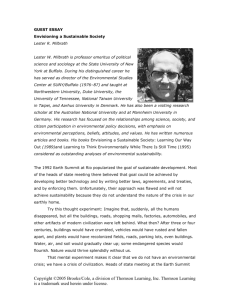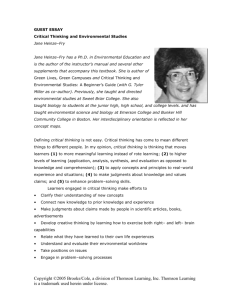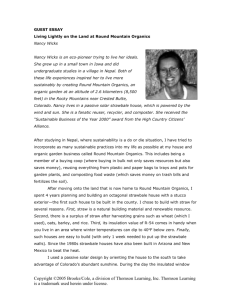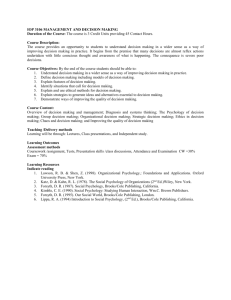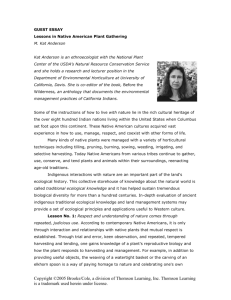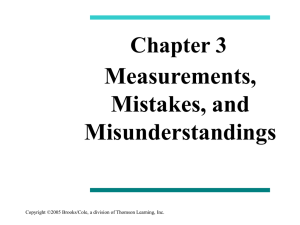Estimating Means with Confidence
advertisement
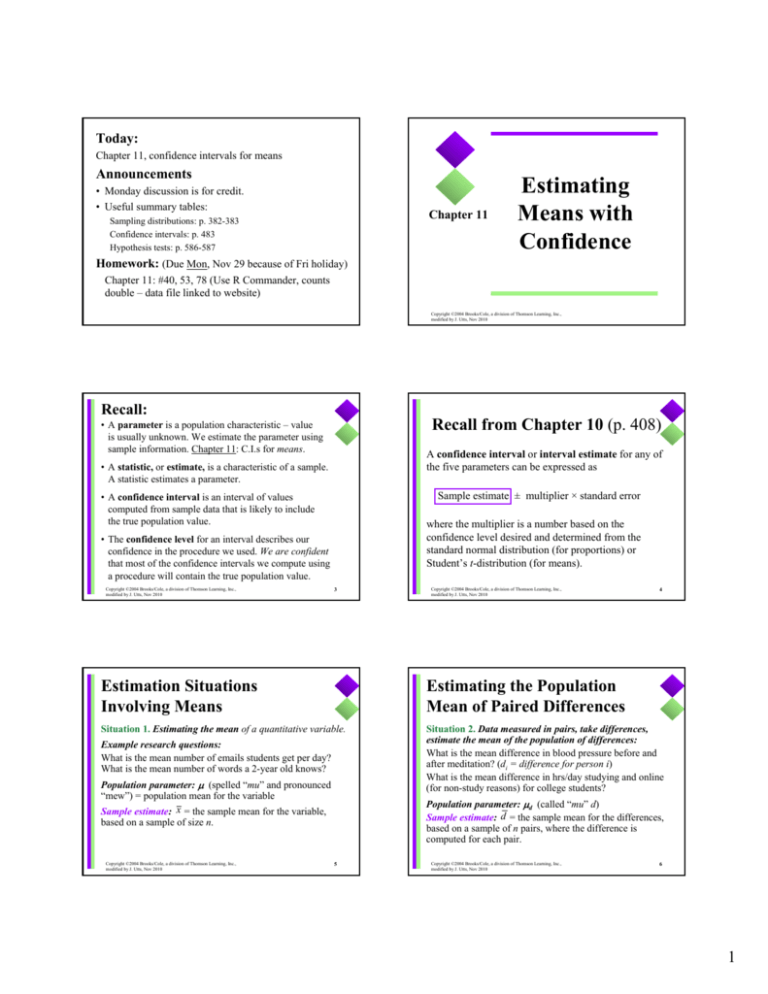
Today: Chapter 11, confidence intervals for means Announcements • Monday discussion is for credit. • Useful summary tables: Chapter 11 Sampling distributions: p. 382-383 Confidence intervals: p. 483 Hypothesis tests: p. 586-587 Estimating Means with Confidence Homework: (Due Mon, Nov 29 because of Fri holiday) Chapter 11: #40, 53, 78 (Use R Commander, counts double – data file linked to website) Copyright ©2004 Brooks/Cole, a division of Thomson Learning, Inc., modified by J. Utts, Nov 2010 Recall: Recall from Chapter 10 (p. 408) • A parameter is a population characteristic – value is usually unknown. We estimate the parameter using sample information. Chapter 11: C.I.s for means. A confidence interval or interval estimate for any of the five parameters can be expressed as • A statistic, or estimate, is a characteristic of a sample. A statistic estimates a parameter. Sample estimate ± multiplier × standard error • A confidence interval is an interval of values computed from sample data that is likely to include the true population value. where the multiplier is a number based on the confidence level desired and determined from the standard normal distribution (for proportions) or Student’s t-distribution (for means). • The confidence level for an interval describes our confidence in the procedure we used. We are confident that most of the confidence intervals we compute using a procedure will contain the true population value. Copyright ©2004 Brooks/Cole, a division of Thomson Learning, Inc., modified by J. Utts, Nov 2010 3 Copyright ©2004 Brooks/Cole, a division of Thomson Learning, Inc., modified by J. Utts, Nov 2010 4 Estimation Situations Involving Means Estimating the Population Mean of Paired Differences Situation 1. Estimating the mean of a quantitative variable. Situation 2. Data measured in pairs, take differences, estimate the mean of the population of differences: What is the mean difference in blood pressure before and after meditation? (di = difference for person i) What is the mean difference in hrs/day studying and online (for non-study reasons) for college students? Example research questions: What is the mean number of emails students get per day? What is the mean number of words a 2-year old knows? Population parameter: µ (spelled “mu” and pronounced “mew”) = population mean for the variable Sample estimate: x = the sample mean for the variable, based on a sample of size n. Copyright ©2004 Brooks/Cole, a division of Thomson Learning, Inc., modified by J. Utts, Nov 2010 Population parameter: µd (called “mu” d) Sample estimate: d = the sample mean for the differences, based on a sample of n pairs, where the difference is computed for each pair. 5 Copyright ©2004 Brooks/Cole, a division of Thomson Learning, Inc., modified by J. Utts, Nov 2010 6 1 Difference in two means Recall from Chapter 10 (p. 408) Situation 3. Estimating the difference between two populations with regard to the mean of a quantitative variable. Example research questions: How much difference is there in average weight loss for those who diet compared to those who exercise to lose weight? How much difference is there in the mean IQs for children whose moms smoked and didn’t during pregnancy? Population parameter: µ1 – µ2 = difference between the two population means. Sample estimate: x1 − x2 = difference between the two sample means. This requires independent samples. Copyright ©2004 Brooks/Cole, a division of Thomson Learning, Inc., modified by J. Utts, Nov 2010 A confidence interval or interval estimate for any of the five parameters can be expressed as Sample estimate ± multiplier × standard error where the multiplier is a number based on the confidence level desired and determined from the standard normal distribution (for proportions) or Student’s t-distribution (for means). 7 Rough Definition: The standard error of a sample statistic measures, roughly, the average difference between the statistic and the population parameter. This “average difference” is over all possible random samples of a given size that can be taken from the population. Technical Definition: The standard error of a sample statistic is the estimated standard deviation of the sampling distribution for the statistic. 9 In practice, the population standard deviation σ is rarely known, so we cannot compute the standard deviation of x , σ s.d.( x ) = . n In practice, we only take one random sample, so we only have the sample mean x and the sample standard deviation s. Replacing σ with s in the standard deviation expression gives us an estimate that is called the standard error of x . s s.e.( x ) = . n From Chapter 9 example of a sample of n = 25 weight losses, the sample standard deviation is s = 4.74 pounds. So the standard error of the mean is 4.74/5 = 0.948 pounds. Copyright ©2004 Brooks/Cole, a division of Thomson Learning, Inc., modified by J. Utts, Nov 2010 10 Standard Error of a Sample Mean Increasing the Size of the Sample Suppose we take n = 100 people instead of just 25. The standard deviation of the mean would be s.e.( x ) = σ 5 = = 0.5 pounds. s.d.( x ) = n 100 s , s = sample standard deviation n Example 11.2 Mean Hours Watching TV • For samples of n = 25, sample means are likely to range between 8 ± 3 pounds => 5 to 11 pounds. • For samples of n = 100, sample means are likely to range only between 8 ± 1.5 pounds => 6.5 to 9.5 pounds. Poll: Class of 175 students. In a typical day, about how much time do you spend watching television? Minitab provides s.e., R Commander doesn’t, but provides s Statistics → Summaries → Numerical summaries, check Standard Deviation VariableN Mean Median TrMean StDev TV 175 2.09 2.000 1.950 1.644 s .e .( x ) = Larger samples tend to result in more accurate estimates of population values than smaller samples. Copyright ©2004 Brooks/Cole, a division of Thomson Learning, Inc., modified by J. Utts, Nov 2010 8 Standard Error of the Mean Standard errors (in general) Copyright ©2004 Brooks/Cole, a division of Thomson Learning, Inc., modified by J. Utts, Nov 2010 Copyright ©2004 Brooks/Cole, a division of Thomson Learning, Inc., modified by J. Utts, Nov 2010 11 SE Mean 0.124 s 1 . 644 = = . 124 n 175 Copyright ©2004 Brooks/Cole, a division of Thomson Learning, Inc., modified by J. Utts, Nov 2010 12 2 Standard Error of the Difference Between Two Sample Means (unpooled) Standard Error for the mean of paired differences s.e.( d ) = sd n s.e.( x1 − x2 ) = where sd = sample standard deviation for the differences Example: How much taller (or shorter) are daughters than their mothers these days? sd = 3.14 (for individuals) n = 93 pairs (daughter – mother) d = 1.3 inches s .e .(d ) = sd 3 . 14 = = . 33 n 93 Copyright ©2004 Brooks/Cole, a division of Thomson Learning, Inc., modified by J. Utts, Nov 2010 Recall from Chapter 10 (p. 408) A confidence interval or interval estimate for any of the five parameters can be expressed as Sample estimate ± multiplier × standard error Study: n1 = 42 men on diet, n2 = 27 men on exercise routine Diet: Lost an average of 7.2 kg with std dev of 3.7 kg Exercise: Lost an average of 4.0 kg with std dev of 3.9 kg So, x1 − x2 = 7.2 − 4.0 = 3.2 kg (3.7 )2 + (3.9)2 42 47 = 0.81 Copyright ©2004 Brooks/Cole, a division of Thomson Learning, Inc., modified by J. Utts, Nov 2010 14 Student’s t-Distribution: Replacing σ with s Dilemma: we generally don’t know σ. Using s we have: t= x−µ x−µ n (x − µ) = = s.e.( x ) s / n s If the sample size n is small, this standardized statistic will not have a N(0,1) distribution but rather a t-distribution with n – 1 degrees of freedom (df). The multiplier is a number based on the confidence level desired and determined from the standard normal distribution (for proportions) or Student’s tdistribution (for means). Copyright ©2004 Brooks/Cole, a division of Thomson Learning, Inc., modified by J. Utts, Nov 2010 Example 11.3 Lose More Weight by Diet or Exercise? and s.e.( x1 − x2 ) = 13 s12 s22 + n1 n2 15 Copyright ©2004 Brooks/Cole, a division of Thomson Learning, Inc., modified by J. Utts, Nov 2010 16 Finding the t-multiplier • Excel: See page 452. • R Commander: Distributions → Continuous distributions → t distribution → t quantiles – – – – – Probabilities: α/2 (for 95%, use .025) Degrees of freedom Lower tail Gives negative of the t-multiplier Ex: .025, 25, lower tail → −2.059539, multiplier ≈ 2.06 • Table A2, page 728 (easy to use compared to z!) 17 18 3 Confidence Interval for One Mean or Paired Data Example: 95% C.I. for Mean Body Temperature Data from a blood bank near Seattle (from friend of Dr. Utts). n = 101 blood donors, ages 17 to 84 (large sample) Sample mean = 97.89 degrees Sample standard deviation = 0.73 degrees A Confidence Interval for a Population Mean x ± t * × s.e.(x ) ⇒ x ± t * × s n where the multiplier t* is the value in a t-distribution with degrees of freedom = df = n - 1 such that the area between -t* and t* equals the desired confidence level. Standard error of the mean = Multiplier = t* with df of 100 = 1.98 (from Table A.2) (Found from Excel, R Commander or Table A.2.) Conditions: • Population of measurements is bell-shaped (no major skewness or outliers) and r.s. of any size > 2; OR • Population of measurements is not bell-shaped, but a large random sample is measured, n ≥ 30. Copyright ©2004 Brooks/Cole, a division of Thomson Learning, Inc., modified by J. Utts, Nov 2010 Sample estimate ± multiplier × standard error 97.89 ± 1.98 × 0.073 97.89 ± 0.14 97.75 to 98.03 degrees (does not cover 98.6) 19 Paired Data Confidence Interval Population parameter: µd = mean of differences for the population (same as µ1 – µ2). Sample estimate: d = sample mean of the differences Standard deviation and standard error: sd = standard deviation of the sample of differences; s s.e.(d ) = d n Confidence interval for µd: d ± t * × s.e. d , ( ) Copyright ©2004 Brooks/Cole, a division of Thomson Learning, Inc., modified by J. Utts, Nov 2010 20 Find 90% C.I. for difference: (daughter – mother) height difference Data: two variables for n individuals or pairs; use the difference d = x1 – x2. where df = n – 1 for the multiplier t*. 0.73 = 0.073 101 How much taller (or shorter) are daughters than their mothers these days? n = 93 pairs (daughter – mother), d = 1.3 inches sd = 3.14 inches, so s .e .(d ) = s d = 3 . 14 = . 33 n 93 Multiplier = t* with 92 df for 90% C.I. = 1.66 (use df=90) Sample estimate ± multiplier × standard error 1.3 ± 1.66 × 0.33 1.3 ± 0.55 0.75 to 1.85 inches (does not cover 0) 21 22 Example 11.9: Small sample, so check for outliers Confidence interval interpretations • We are 95% confident that the mean body temperature for healthy adults (who would donate blood??) is between 97.75 degrees and 98.03 degrees. • We are 90% confident that the mean height difference between female college students and their mothers is between 0.75 and 1.85 inches, with students being taller than their mothers. 23 Data: Hours spent watching TV and hours spent on computer per week for n = 25 students. Create a 90% CI for the mean difference in hours spent using computer versus watching TV. Note: Boxplot shows no obvious skewness and no outliers. Copyright ©2004 Brooks/Cole, a division of Thomson Learning, Inc., modified by J. Utts, Nov 2010 24 4 Example 11.9 Screen Time: Computer vs TV Results: d = 5.36, sd = 15.24, and s.e.(d ) = sd 15.24 = = 3.05 n 25 A CI for the Difference Between Two Means Multiplier t* from Table A.2 with df = 24 is t* = 1.71 (Independent Samples, unpooled case): 90% Confidence Interval: 5.36 ± 1.71(3.05) => 5.36 ± 5.22 => 0.14 to 10.58 hours x1 − x2 ± t * s12 s22 + n1 n2 where t* is the value in a t-distribution with area between -t* and t* equal to the desired confidence level. Interpretation: We are 90% confident that the average difference between computer usage and television viewing for students represented by this sample is covered by the interval from 0.14 to 10.58 hours per week, with more hours spent on computer usage than on television viewing. Copyright ©2004 Brooks/Cole, a division of Thomson Learning, Inc., modified by J. Utts, Nov 2010 11.4 CI for Difference Between Two Means (Independent samples) 25 Copyright ©2004 Brooks/Cole, a division of Thomson Learning, Inc., modified by J. Utts, Nov 2010 Necessary Conditions Degrees of Freedom • Two samples must be independent. The t-distribution is only approximately correct and df formula is complicated (Welch’s approx): 26 Either … • Populations of measurements both bell-shaped, and random samples of any size are measured. or … Statistical software can use the above approximation, but if done by hand then use a conservative df = smaller of (n1 – 1) and (n2 – 1). • Large (n ≥ 30) random samples are measured. 27 Copyright ©2004 Brooks/Cole, a division of Thomson Learning, Inc., modified by J. Utts, Nov 2010 Example 11.11 Effect of a Stare on Driving Example 12.8 Effect of a Stare on Driving Randomized experiment: Researchers either stared or did not stare at drivers stopped at a campus stop sign; Timed how long (sec) it took driver to proceed from sign to a mark on other side of the intersection. Checking Conditions: No Stare Group (n = 14): 8.3, 5.5, 6.0, 8.1, 8.8, 7.5, 7.8, 7.1, 5.7, 6.5, 4.7, 6.9, 5.2, 4.7 Stare Group (n = 13): 5.6, 5.0, 5.7, 6.3, 6.5, 5.8, 4.5, 6.1, 4.8, 4.9, 4.5, 7.2, 5.8 Boxplots show … • No outliers and no strong skewness. • Crossing times in stare group generally faster and less variable. Task: Make a 95% CI for the difference between the mean crossing times for the two populations represented by these two independent samples. Copyright ©2004 Brooks/Cole, a division of Thomson Learning, Inc., modified by J. Utts, Nov 2010 28 29 Copyright ©2004 Brooks/Cole, a division of Thomson Learning, Inc., modified by J. Utts, Nov 2010 30 5 Example 12.8 Effect of a Stare on Driving Approximate 95% CI For sufficiently large samples, the interval Sample estimate ± 2 × Standard error is an approximate 95% confidence interval for a population parameter. Note: The df = 21 was reported by the computer package based on the Welch’s approximation formula. The 95% confidence interval for the difference between the population means is 0.14 seconds to 1.93 seconds . Copyright ©2004 Brooks/Cole, a division of Thomson Learning, Inc., modified by J. Utts, Nov 2010 31 Example 11.13 Diet vs Exercise Study: n1 = 42 men on diet, n2 = 47 men exercise Diet: Lost an average of 7.2 kg with std dev of 3.7 kg Exercise: Lost an average of 4.0 kg with std dev of 3.9 kg So, x1 − x2 = 7.2 − 4.0 = 3.2 kg and s.e.( x1 − x2 ) = 0.81 kg Approximate 95% Confidence Interval: 3.2 ± 2(.81) => 3.2 ± 1.62 => 1.58 to 4.82 kg Note: We are 95% confident the interval 1.58 to 4.82 kg covers the higher mean weight loss for dieters compared to those who exercised. The interval does not cover 0, so a real difference is likely to hold for the population as well. Copyright ©2004 Brooks/Cole, a division of Thomson Learning, Inc., modified by J. Utts, Nov 2010 t*(30) = 2.04, t*(60) = 2.00, t*(90) = 1.99, t*(∞) = z* = 1.96 Copyright ©2004 Brooks/Cole, a division of Thomson Learning, Inc., modified by J. Utts, Nov 2010 32 Using R Commander • Read in or enter data set • Statistics → Means → – Single sample t-test – Independent samples t-test (requires data in one column, and group code in another) – Paired t-test (requires the original data in two separate columns) 33 Example: Exercise 11.51 Two-sample t-test to compare pulse • • • • Note: Except for very small degrees of freedom, the multiplier t* for 95% confidence interval is close to 2. So, 2 is often used to approximate, rather than finding degrees of freedom. For instance, for 95% C.I.: 34 Should check for outliers with small sample(s) Graphs→Boxplot→Plot by Group This looks okay – no outliers or major skew Data → New data set – give name, enter data One column for Exercise (Y,N) one for pulse Statistics → Means →Independent samples t-test Choose the alternative (≠,>,<) and conf. level data: Pulse by Exercises t = 1.7156, df = 13.014, p-value = 0.05496 alternative hypothesis: true difference in means is not equal to 0 95 percent confidence interval: -1.727387 15.060720 sample estimates: mean in group N mean in group Y 72.00000 65.33333 35 36 6 Confidence interval applet http://www.rossmanchance.com/applets/Confsim/Confsim.html 7

